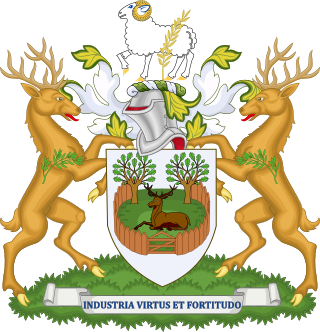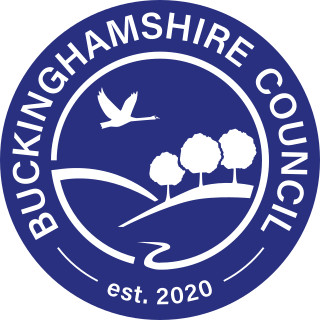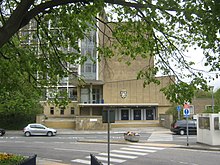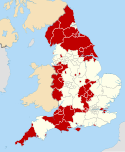
Isle of Wight Council, known between 1890 and 1995 as Isle of Wight County Council, is the local authority for the Isle of Wight in England. Since 1995 it has been a unitary authority, having also taken on district-level functions when the county's districts were abolished. It is based at County Hall in Newport. The council has been under no overall control since 2021, being led by a coalition of independent, Green, and Our Island councillors called the Alliance Group.

Newcastle City Council is the local authority for Newcastle upon Tyne, a metropolitan borough with city status in the ceremonial county of Tyne and Wear in North East England. The council consists of 78 councillors, three for each of the 26 wards in the city. It has been under Labour majority control since 2011. The council is a constituent member of the North East Mayoral Combined Authority.
Darlington Borough Council elections are held every four years. Darlington Borough Council is the local authority for the unitary authority of Darlington in County Durham, England. Until 1 April 1997 it was a non-metropolitan district.
Durham County Council elections are held every four years. Durham County Council is the local authority for the unitary authority of County Durham. Since becoming a unitary authority, 126 councillors have been elected from 63 wards.
Derwentside District Council elections were generally held every four years between the council's creation in 1974 and its abolition in 2009. Derwentside was a non-metropolitan district in County Durham, England. On 1 April 2009 the council's functions passed to Durham County Council, which became a unitary authority.

The Borough of Darlington is a local government district with borough status in County Durham, England. Since 1997 Darlington Borough Council has been a unitary authority, with both district-level and county-level functions; it is independent from Durham County Council. It is named after its largest settlement, the town of Darlington, where the council is based. The borough also includes a rural area surrounding the town which contains several villages. The population of the borough at the 2021 census was 107,800, of which over 86% (93,015) lived in the built-up area of Darlington itself.

The Borough of Hartlepool is a local government district with borough status in County Durham, England. Since 1996 Hartlepool Borough Council has been a unitary authority, which gives it both district-level and county-level functions; it is independent of Durham County Council. It is named after its largest settlement, Hartlepool, where the council is based. The borough also includes a rural area to the west of the town. The population of the borough at the 2021 census was 92,571, of which over 95% (87,995) lived in the built-up area of Hartlepool itself.

Middlesbrough Council, also known as Middlesbrough Borough Council, is the local authority for Middlesbrough, in the ceremonial county of North Yorkshire, England. Since 1996 it has been a unitary authority, providing both district-level and county-level services. The council is led by the directly elected Mayor of Middlesbrough.

Northumberland County Council is the local authority for the non-metropolitan county of Northumberland in North East England. Since 2009 it has been a unitary authority, having also taken over district-level functions when the county's districts were abolished.
Sedgefield Borough Council elections were generally held every four years between the council's creation in 1974 and its abolition in 2009. Sedgefield was a non-metropolitan district in County Durham, England. On 1 April 2009 the council's functions passed to Durham County Council, which became a unitary authority.

Ipswich Borough Council is the local authority for Ipswich, a non-metropolitan district with borough status in Suffolk, England. It is the second tier of a two-tier system, fulfilling functions such as refuse collection, housing and planning, with Suffolk County Council providing county council services such as transport, education and social services.

Telford and Wrekin Council is the local authority of Telford and Wrekin in Shropshire, England. It is a unitary authority, having the powers of a county council and district council combined.

Derby City Council is the local authority for Derby, a unitary authority with city status in the East Midlands region of England.

Cheshire East Council is the local authority for Cheshire East, a local government district with borough status in the ceremonial county of Cheshire, England. The council is a unitary authority, being a district council which also performs the functions of a county council. It has been under no overall control since 2019, being run by a coalition of Labour, local parties and independent councillors, led by Labour councillor Sam Corcoran. The council's main offices are in Sandbach, but there are plans to move them to Crewe.

Stockton-on-Tees Borough Council is the local authority of the Borough of Stockton-on-Tees, which straddles the ceremonial counties of County Durham and North Yorkshire in England. Since 1996 the council has been a unitary authority, providing both district-level and county-level services. It therefore provides services including Council Tax billing, libraries, social services, town planning, waste collection and disposal, and it is a local education authority. Since 2016 the council has been a member of the Tees Valley Combined Authority, which has been led by the directly elected Tees Valley Mayor since 2017.

Blackpool Council is the local authority of the Borough of Blackpool, Lancashire, England. It is a unitary authority, having the powers of a county council and district council combined.

North Tyneside Council is the local authority for the metropolitan borough of North Tyneside in Tyne and Wear, England. It is one of five such councils in Tyne and Wear, and one of 36 in England. It provides the majority of local government services in North Tyneside.

Calderdale Metropolitan Borough Council is the local authority for the Metropolitan Borough of Calderdale in West Yorkshire, England. The council styles itself Calderdale Council. It is a metropolitan district council, one of five in West Yorkshire and one of 36 in the metropolitan counties of England. It provides the majority of local government services in Calderdale. Since 2014 the council has been a constituent member of the West Yorkshire Combined Authority.

Buckinghamshire Council is the local authority for the non-metropolitan county of Buckinghamshire in England. It is a unitary authority, performing both county and district-level functions. It was created on 1 April 2020, replacing the previous Buckinghamshire County Council and the councils of the four abolished districts of Aylesbury Vale, Chiltern, South Bucks, and Wycombe. The non-metropolitan county is smaller than the ceremonial county, which additionally includes Milton Keynes.

County Durham is a local government district in the ceremonial county of County Durham, England. It is governed by Durham County Council, a unitary authority. The district has an area of 2,232.6 km2, and contains 135 civil parishes. It forms part of the larger ceremonial county of Durham, together with boroughs of Darlington, Hartlepool, and the part of Stockton-on-Tees north of the River Tees.




















